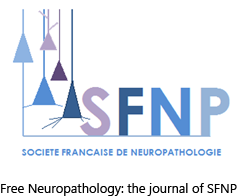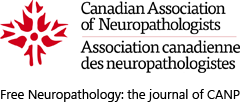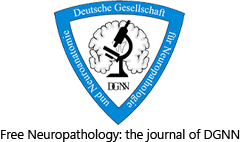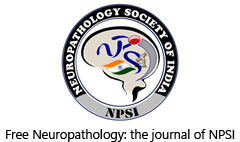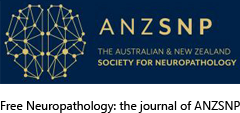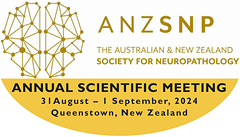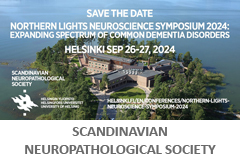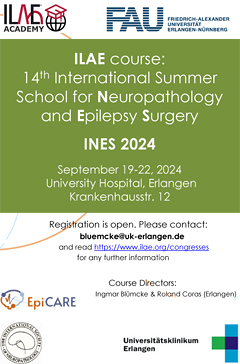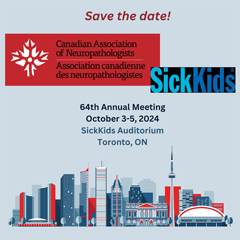Clinicopathological updates

Coronavirus disease 2019 (COVID-19) is emerging as the greatest public health crisis in the early 21st century. Its causative agent, Severe Acute Respiratory Syndrome coronavirus 2 (SARS-CoV-2), is an enveloped single-stranded positive-sense ribonucleic acid virus that enters cells via the angiotensin converting enzyme 2 receptor or several other receptors. While COVID-19 primarily affects the respiratory system, other organs including the brain can be involved. In Western clinical studies, relatively mild neurological dysfunction such as anosmia and dysgeusia is frequent (~70-84%) while severe neurologic disorders such as stroke (~1-6%) and meningoencephalitis are less common. It is unclear how much SARS-CoV-2 infection contributes to the incidence of stroke given co-morbidities in the affected patient population. Rarely, clinically-defined cases of acute disseminated encephalomyelitis, Guillain-Barré syndrome and acute necrotizing encephalopathy have been reported in COVID-19 patients. Common neuropathological findings in the 184 patients reviewed include microglial activation (42.9%) with microglial nodules in a subset (33.3%), lymphoid inflammation (37.5%), acute hypoxic-ischemic changes (29.9%), astrogliosis (27.7%), acute/subacute brain infarcts (21.2%), spontaneous hemorrhage (15.8%), and microthrombi (15.2%). In our institutional cases, we also note occasional anterior pituitary infarcts. COVID-19 coagulopathy, sepsis, and acute respiratory distress likely contribute to a number of these findings. When present, central nervous system lymphoid inflammation is often minimal to mild, is detected best by immunohistochemistry and, in one study, indistinguishable from control sepsis cases. Some cases evince microglial nodules or neuronophagy, strongly supporting viral meningoencephalitis, with a proclivity for involvement of the medulla oblongata. The virus is detectable by reverse transcriptase polymerase chain reaction, immunohistochemistry, or electron microscopy in human cerebrum, cerebellum, cranial nerves, olfactory bulb, as well as in the olfactory epithelium; neurons and endothelium can also be infected. Review of the extant cases has limitations including selection bias and limited clinical information in some cases. Much remains to be learned about the effects of direct viral infection of brain cells and whether SARS-CoV-2 persists long-term contributing to chronic symptomatology.

Alzheimer’s disease (AD), the most common form of dementia worldwide, is a mixed proteinopathy (amyloid and tau). Originally defined as a clinicopathological entity, it is a heterogenous, multifactorial disorder, currently referred to as the Alzheimer’s continuum. Its cardinal pathological features are extracellular β-amyloid (amyloid plaques) and intraneuronal tau aggregates forming neurofibrillary tangles, which are accompanied by vascular amyloid deposits (cerebral amyloid angiopathy), synapse and neuronal loss, as well as neuroinflammation and reactive astrogliosis. In addition to “typical” AD, various subtypes with characteristic regional patterns of tau pathology have been described that show distinct clinical features, biomarker levels, and patterns of key network destructions responsible for cognitive decline. AD is frequently associated with other age-related changes including Lewy and TDP-43 pathologies, hippocampal sclerosis, argyrophilic grain disease, cerebrovascular lesions, and others. These additional pathologies influence the clinical picture of AD, may accelerate disease progression, and can cause a number of challenges in our understanding of the disease including the threshold of each individual pathology to cause dementia and the possibility of underlying common etiologies. This article provides an up-to-date overview of AD neuropathology, its heterogeneity, and additional pathologies in order to explain the difficulties in the diagnosis and the failure of clinical trials in AD patients.
Multiple system atrophy (MSA) is a fatal, adult-onset neurodegenerative disorder of uncertain etiology, clinically characterized by various combinations of Levo-dopa-unresponsive parkinsonism, cerebellar, motor, and autonomic dysfunctions. MSA is an α-synucleinopathy with specific glioneuronal degeneration involving striatonigral, olivopontocerebellar, autonomic and peripheral nervous systems. The pathologic hallmark of this unique proteinopathy is the deposition of aberrant α-synuclein (αSyn) in both glia (mainly oligodendroglia) and neurons forming pathological inclusions that cause cell dysfunction and demise. The major variants are striatonigral degeneration (MSA with predominant parkinsonism / MSA-P) and olivopontocerebellar atrophy (MSA with prominent cerebellar ataxia / MSA-C). However, the clinical and pathological features of MSA are broader than previously considered. Studies in various mouse models and human patients have helped to better understand the molecular mechanisms that underlie the progression of the disease. The pathogenesis of MSA is characterized by propagation of disease-specific strains of αSyn from neurons to oligodendroglia and cell-to-cell spreading in a "prion-like" manner, oxidative stress, proteasomal and mitochondrial dysfunctions, myelin dysregulation, neuroinflammation, neurotrophic factor decrease, and energy failure. The combination of these mechanisms results in neurodegeneration with widespread demyelination and a multisystem involvement that is specific for MSA. Clinical diagnostic accuracy and differential diagnosis of MSA have improved by using combined biomarkers. Cognitive impairment, which has been a non-supporting feature of MSA, is not uncommon, while severe dementia is rare. Despite several pharmacological approaches in MSA models, no effective disease-modifying therapeutic strategies are currently available, although many clinical trials targeting disease modification, including immunotherapy and combined approaches, are under way. Multidisciplinary research to elucidate the genetic and molecular background of the noxious processes as the basis for development of an effective treatment of the hitherto incurable disorder are urgently needed.
Dementia is one of the major burdens of our aging society. According to certain predictions, the number of patients will double every 20 years. Although Alzheimer’s disease (AD), as the most frequent neurodegenerative dementia, has been extensively analysed, less is known about dementia with Lewy bodies (DLB). Neuropathological hallmarks of DLB are the deposition of intracellular Lewy bodies (LB) and Lewy neurites (LN). DLB belongs to the α-synucleinopathies, as the major component of these inclusions is pathologically aggregated α-synuclein. Depending on the localisation of LBs and LNs in the central nervous system cognitive and motor symptoms can occur. In our work, we will systematically review the possible etiology and epidemiology, pathological (both macroscopic and microscopic) features, structural and functional imaging findings, with a special emphasis on the clinico-pathological correlations. Finally, we summarize the latest clinical symptoms-based diagnostic criteria and the novel therapeutic approaches. Since DLB is frequently accompanied with AD pathology, highlighting possible differential diagnostic approaches is an integral part of our paper. Although our present knowledge is insufficient, the rapid development of diagnostic and research methods provide hope for better diagnosis and more efficient treatment, contributing to a better quality of life.






